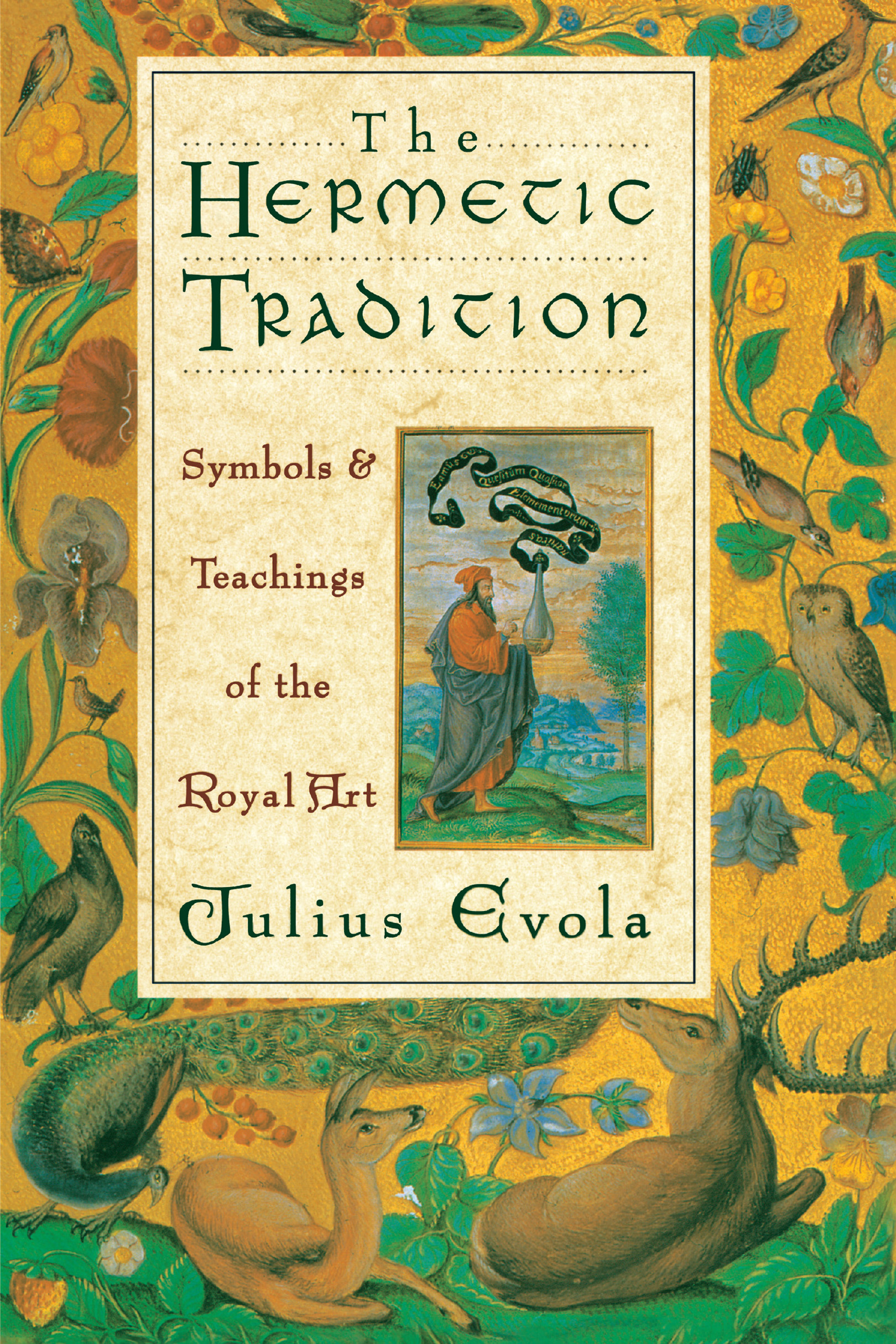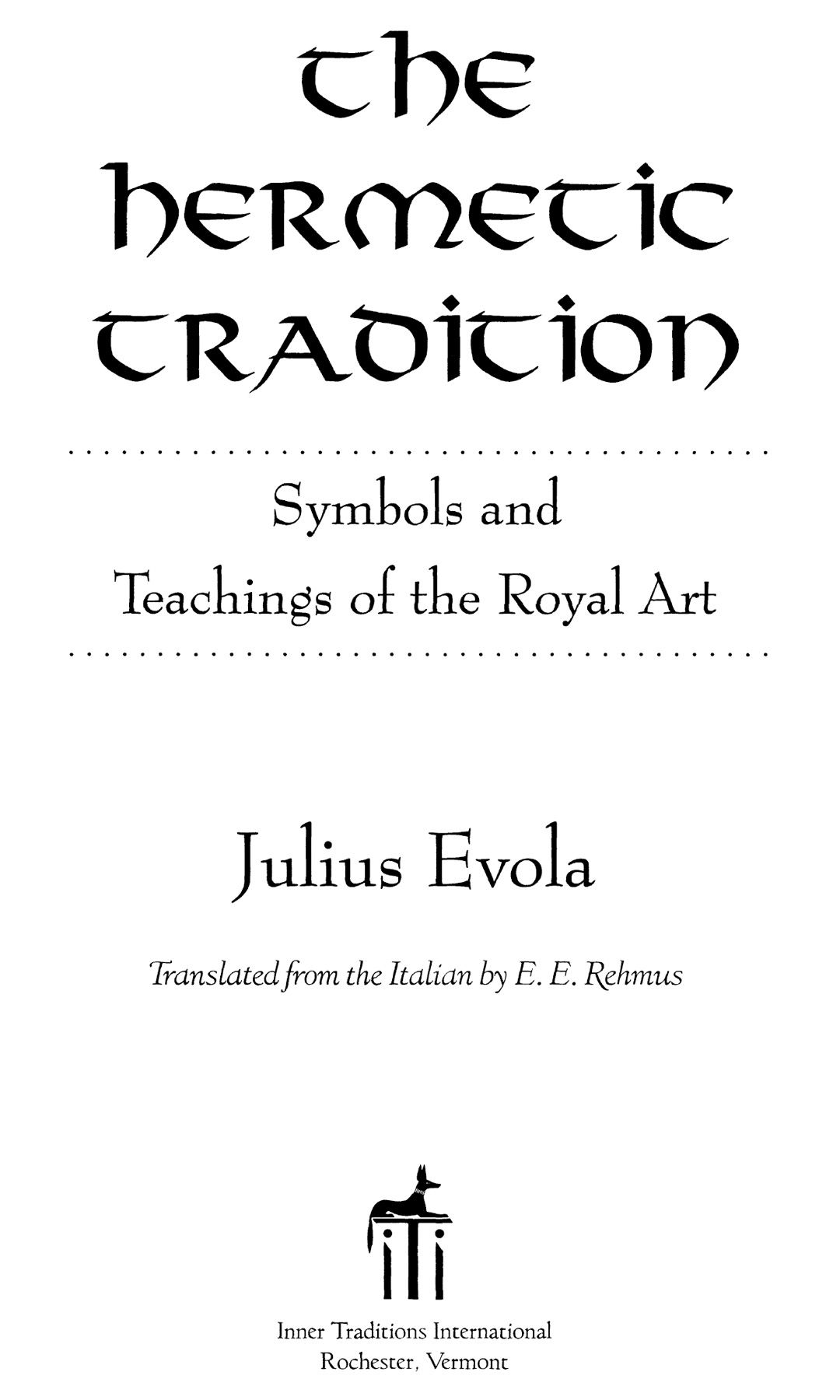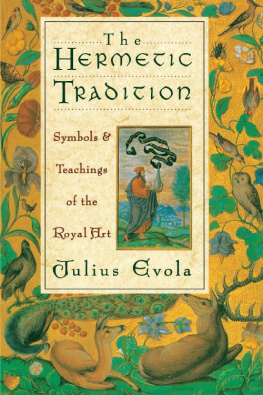

FOREWORD
F or Julius Evola (18981974) alchemy was notas is generally believeda single specialized subject concerning itself exclusively with metals and their correspondences in man, but rather a comprehensive physical and metaphysical system embracing cosmology as much as anthropology (in the sense of a complete knowledge of man in body, soul, and spirit). Everythingnature and supernaturecan be found in it. To Evola, hermetism and alchemy are one and the same.
The goal of this system is the understanding and experiencing of an ensouled "holy" organism, replete with living powers, in whom everything is wonderfully interwoven, connected to and communized with everything else. Man stands in the middle where he is microcosm in analogy to the whole macrocosm As above, so belowin the words of the Emerald Tablet. The alchemical symbol language as the expression of this universal system must therefore also have correspondences in all the other mysteriosophic spheres and can consequently serve as a universal key in these spheres, just as, vice versa, any other mystery teaching has the power to fill in the lacunae of esotericism in alchemy.
Alongside Arturo Reghini (18781946)and surely also at his suggestionEvola was one of the few in those years who were aware of this parallel, especially to ancient theurgical practice. In 1926 Evola published an article inUltra (the newspaper of the unusually liberal Theosophical lodge in Rome) on the cult of Mithras in which he placed major emphasis on the similarities of these mysteries with hermetism. In the UR group (192729), of which Evola was a member, specific alchemical symbols were employed in the teaching of "Magic." but much more than that it is an exercise of soul and spirit in the best Platonic tradition.
Where did Evola's early preoccupation with alchemical symbolism come from? After his Dadaist and philosophical period, Evola came in contact with Theosophical and Freemason circles. In his autobiography Evola quotes from early translations of Ren Gunon'sLe voile d'Isis (later the cudes traditionelles), which also gave him suggestions for his vision of alchemy.
Jacopo da Coreglia laid the groundwork for his understanding of the four elements. Where this group in turn got its knowledge remains a secret. In its own view, and Jacopo da Coreglia also shares this opinion, the Myriam (which seems to have split into many groups) is the last torch-bearer of a tradition that has been handed downunder constantly changing namesfrom the classical times of Pythagorean paganism and it is independent of the Freemasons or similar contemporary movements. In hisPour la Rose Rouge et la Croix d'Or Count J. P. Giudicelli de Cressac Bachellerie reveals its inner structure and current grading process.
In addition, there is the decisive influence of Ercole Quadrelli, who under the pseudonyms of Abraxas and Tikaipos, made some especially important contributions to the UR group. And it should be mentioned in this regard that Quadrelli was trained by Giuliano Kremmerz and the Myriam.
The freely accessible works of KremmerzI dialoghi sull'ermetismo (Dialogues on hermetics) and his magazine Commentarium (191012)also did much for Evola's spiritual development in the realm of alchemy. His acquaintance with the Chymica vannus and with the alchemist Philalethes probably go back to these works.
The strongest and perhaps decisive influence on the Evolian conception of alchemy as a universal system is probably Cesare Della Riviera'sIl mondo magico degli heroi (The magical world of the heroes), (Mantua, 1603; Milan, 1605). This is one of the few texts of that time that helps itself to a hermetico-alchemical language, but is of an unequivocally halo-cosmological character. Alchemy is always placed in perspective with the other hermetic disciplinessuch as magic and astrologyand is not regarded as an autonomous and specific teaching. For an alchemical book the unusually many references to the Abbot Johannes Trithemius (14621516) in this work point also in this direction.
The first tangible result of these studies was shown in the periodical Krur (sequel to UR). There Evola presented a first shot at discussing the hermetic tradition and anticipated the essential content of the later book. The alchemical tradition was still portrayed only as pagan and not as aroyal tradition, an attribute that in the final edition received so central a position that it brought Evola into conflict with other representatives of the traditional weltanschauung.
A broader and altogether different influence on Evola at this time came as a result of his meeting the Indian alchemist C. S. Narayana Swami Aiyar of Chingleput, who expounded on the great importance of the breathing techniques in alchemy and how it helped to ingest certain substances.
In 1930 Evola wrote "The Doctrine of Transmutation in Medieval Hermetics" for Bilychnis (no. 275). In abridged form, the articled contained the fundamental precepts of La tradizione ermetica, which was published by Laterza in 1931. (The 1931 edition was insignificantly altered and expanded in 1948. This was followed in 1971 by Evola's last revision, which is the basis for this translation.)
It is interesting in this regard that Benedetto Croce was instrumental in helping Evola to make contact with this eminent publishing house. In the archives of Laterza are several of Evola's unpublished letters that refer toThe Hermetic Tradition, and in which Croce's mediation appears again and again. One letter in particular is important, for in it Evola seems to answer the publisher's reproaches that the work was overloaded with annotations and had too little public appeal. Evola argued that it was not written for public appeal but only and simply to show for the first time that alchemy was not just the beginning of chemistry, but a profound and forgotten mystery-science; and without the abundance of quotations Evola would be marked as a visionary and the publisher criticized for not being serious.
Evola's conviction that alchemy was a universal system clarifies his endeavor to see this work as the completion and synthesis of all his earlier works in philosophy, magic, and Tantrism. Hence his emphasis on the preor, more correctly, super-Christian character of the hermetic tradition.
Naturally, Evola's belief in the all-inclusive character of hermetism did not go unchallenged. Certainly his most important critic was the second great herald of Tradition, Ren Gunon, to whom Evola, nevertheless, was indebted for outstanding insights (and the idea of the Tradition in the first place).
In his review of The Hermetic Tradition in the Voile d'Isis in April of 1931, though basically positive, Gunon rejects quite strongly the idea that alchemy is a complete metaphysical doctrine and reduces it to the status of a mere cosmological system. According to him, a true tradition could never have come from an Egypto-Hellenic origin, then passed on to Islamic esotericism, and from there to Christian esotericism. In addition, alchemy had always been integrated into these various currents, whereas a pure and complete tradition has no need for some other tradition serving as an auxiliary vehicle. Moreover, it is an indication of the special character of alchemy that this path of knowledge in traditional societies should be a domain of the second caste, of the Kshatriyas (warrior caste), whereas only the Brahmins were truly dedicated to metaphysics. The last argument was correct, as far as Evola was concerned, for he had always seen himself as Kshatriya and for him alchemy and the possibility of continuing to experiment on the spiritual planethe "art" aspectwere extremely important. Nevertheless, the present work and its representation of alchemy is no willful or special interpretation on Evola's part, although on the ground of his "personal equation" some aspects may have been given a stronger emphasisespecially the active and the inner alchemy(
Next page







